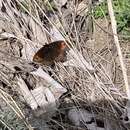en
names in breadcrumbs


The de Prunner's ringlet (Erebia triarius) is a member of the subfamily Satyrinae of the family Nymphalidae.[1]
It is a mountain butterfly found in Albania, Andorra, Austria, Switzerland, France, Italy, Spain, Portugal and Yugoslavia.
E. evias God. (= bonellii Hbn.) (3.5 g). Always somewhat larger than the preceding [stygne] : the upperside of the wings dark black-brown , the forewing with a russet-red or reddish yellow transverse band bearing 5 white-centred black ocelli of different sizes, 3 of them standing near the costa and being united, while the 2 others stand further back and are somewhat smaller. The band of the hindwing consists of 4-5 oval brown spots, each bearing a white-centred black ocellus. The forewing beneath is similarly marked as above, the hindwing of the male being black, thinly dusted with grey, and bearing a more or less dark median band which is somewhat excurved between the veins. In the lighter discal margin there are 3-5 white-pupilled black ocelli. The female is brownish grey beneath, costal and distal margins of the forewing marmorated with grey and brown like the hindwing, the median band of the latter being more prominent than in the male. — The smaller form from the Pyrenees, pyrenaica Stgr., has the underside more strongly marked, the russet-red band is narrower and the ocelli are absent or strongly reduced. — The form hispanica Zap. (37 a) is somewhat smaller, the transverse band being lighter in both sexes, the ocelli smaller, and the upper 3 ocelli in the band of the forewing moreover are not united as in nymotypical erias, but stand separated one below the other. — The species appears already the middle of May in warmer localities, flying from June to August at higher altitudes, and occurs on grassy slopes; plentiful in most f!ight places. The insect is found in the Pyrenees, the lower Alps of Southern France, in Wallis and the Southern Tyrol.[2]
The de Prunner's ringlet (Erebia triarius) is a member of the subfamily Satyrinae of the family Nymphalidae.
Erebia triarius
Le Moiré printanier (Erebia triarius ou E. triaria) est un lépidoptère (papillon) appartenant à la famille des Nymphalidae, à la sous-famille des Satyrinae et au genre Erebia.
Erebia triarius a été nommé par Leonardo De Prunner en 1798.
Synonymes : Erebia hispanica Gumppenberg, 1888 ; Erebia triaria de Prunner, 1798 ; Erebia triaria pyrenaica (Prunner, 1798) ; Papilio evias Godart, 1823[1].
Le Moiré printanier se nomme de Prunner's Ringlet en anglais et Alpen-Mohrenfalter en allemand[2].
Le Moiré printanier est un petit papillon, marron foncé barré d'une bande postpostdiscale de couleur orange ornée d'ocelles noirs centrés de blanc de taille inégale, généralement cinq aux antérieures et quatre aux postérieures.
Le revers des antérieures est identique, celui des postérieures est marron, sans ornementation, plus foncé chez le mâle, plus clair chez la femelle.
Il vole de mi-avril à mi-juillet suivant le lieu et l'altitude[3].
Les plantes hôtes des chenilles sont diverses poacées (graminées) : Festuca ovina, Poa pratensis et des Stipa[3].
Il est présent dans le sud de l'Europe sous forme de nombreux isolats dans le nord du Portugal et de l'Espagne, sud de la France et de la Suisse, nord de l'Italie, sud de l'Autriche, ouest de la Slovénie, sud de la Bosnie et de la Serbie et Albanie[2],[3].
En France métropolitaine il est présent dans les Pyrénées, départements des Pyrénées-Atlantiques, Hautes-Pyrénées, Haute-Garonne, Ariège Aude et Pyrénées-Orientales,et les Alpes, départements des Hautes-Alpes, Alpes-de-Haute-Provence, Alpes-Maritimes, Savoie, Isère, Drôme et Vaucluse[4].
Il réside dans les clairières[3].
Pas de statut de protection particulier[5].
Erebia triarius
Le Moiré printanier (Erebia triarius ou E. triaria) est un lépidoptère (papillon) appartenant à la famille des Nymphalidae, à la sous-famille des Satyrinae et au genre Erebia.
De zuidelijke erebia (Erebia triarius) is een vlinder uit de onderfamilie Satyrinae van de familie Nymphalidae, de vossen, parelmoervlinders en weerschijnvlinders.
De zuidelijke erebia komt voor in de Alpen, de Pyreneeën en zuidelijker in berggebieden in de noordelijke helft van het Iberisch schiereiland en in het voormalige Joegoslavië en Albanië. De vlinder vliegt op hoogtes van 400 tot 2500 meter boven zeeniveau. In de Alpen vooral in open zeer droog grasland, zuidelijker ook in open plekken in rotsige bossen.
De soort vliegt in een jaarlijkse generatie van april tot in juli.
De bekende waardplanten van de zuidelijke erebia zijn genaald schapengras (Festuca ovina), veldbeemdgras (Poa pratensis), Poa alpina en Stipa pennata. De volwassen dieren bezoeken bloemen. De soort overwintert als rups.
BronnenNa generassion a l'ann, da avril an bass, an magg-giugn pì an su.
A viv an sj'Alp, da 500 a 2500 méter.
Na generassion a l'ann, da avril an bass, an magg-giugn pì an su.
DistribussionA viv an sj'Alp, da 500 a 2500 méter.
Erebia triarius é uma espécie de insetos lepidópteros, mais especificamente de borboletas pertencente à família Nymphalidae.[1]
A autoridade científica da espécie é de Prunner, tendo sido descrita no ano de 1798.
Trata-se de uma espécie presente no território português.
Erebia triarius é uma espécie de insetos lepidópteros, mais especificamente de borboletas pertencente à família Nymphalidae.
A autoridade científica da espécie é de Prunner, tendo sido descrita no ano de 1798.
Trata-se de uma espécie presente no território português.
Чернушка триария (лат. Erebia triaria) — дневная бабочка из семейства бархатниц, вид рода Erebia.
Горный вид. Ареал включает: Албания, Андорра, Австрия, Швейцария, Франция, Италия, Испания, Португалия, Югославия.
В Пиренеях и Альпах вид встречается на высотах от 400 до 2500 м н.у.м., преимущественно на высотах 1500-1700 м н.у.м. Обитает на травянистых склонах гор. Редкий и локальный вид.
Время лёта: с апреля по конец июня. Кормовые растения гусениц: Festuca ovina, Poa pratensis, Poa alpina и Stipa pennata.